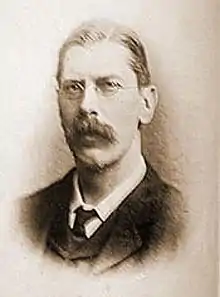Harry James Powell
Harry James Powell CBE (24 January 1853 – 26 November 1922) was a British glassmaker associated with the Arts and Crafts Movement. He was manager and chief glassmaker of James Powell and Sons from 1875 to 1919. He is best known for his innovations in the production of vessel glass, his contributions of new, medieval-like glass to the Arts and Crafts Movement, and the invention of innovative glass materials designed for the war effort during World War I.
Harry James Powell | |
|---|---|
 Harry James Powell 1875 | |
| Born | 24 January 1853 Walthamstow, Essex, England |
| Died | 26 November 1922 (aged 69) |
| Nationality | British |
| Alma mater | Trinity College |
| Known for | Glassmaking |
| Movement | Arts and Crafts Movement |
| Awards | Knight Commander of the Order of the British Empire |
Biography
Harry James Powell was the grandson of James Powell, founder of James Powell and Sons Glass Company (originally known as Whitefriars Glassworks) in London. Powell graduated from Trinity College, Oxford in 1873, where he studied mechanics, physics and chemistry.[1]
Powell was hired at Powell's in 1873. He managed the company beginning in 1875 until his retirement in 1919. He was made a partner of the firm in 1893.[1] Powell was chief designer of glassware. His intricate designs of vases, bowls and glassware had a strong following, as the interest and demand for Arts and Crafts Movement style glass and later Art Nouveau glass soared.[1]

From the beginning of his career, Powell studied the history of glass and glass making. He scientifically analyzed historic glassware and would to try to recreate the old glass. He also investigated new kinds of glass. Powell discovered that by exposing glass to higher temperatures, he could change the colour in dramatic ways. By 1877, Powell had successfully produced new opalescent glass, a milky opaque straw opal and blue opal, which were very well received in the America.[1]

In the early 1890s, Powell was experimenting with new glass colours, trying to replicate medieval glass. The new colours were developed for the use in the mosaics designed by William Blake Richmond for St. Paul's Cathedral. The new, heavier glass, often with light veins of colour, expanded the company's glass palette and was highly favored by artists of the Arts and Crafts Movement.[2] Powell wrote down his experiments and made detailed notes of his impressions and work in notebooks. The notebooks are now preserved in the British Museum.[3]
At the beginning of the 20th century, Powell applied his scientific knowledge to create new products that were used in science, industry and the war effort in the First World War. Powell's innovations include x-ray tubes, light bulbs, and new thermometers. "His development of toughened glass for thermometer tubes, optical glass and ultimately for toughened glass for use on naval mines in World War I earned him his CBE, but brought the company through the difficult war years and able to expand vigorously afterwards".[1]
In 1919, Powell retired from the company. He was made a Commander of the Order of the British Empire for his services during the First World War, which included the products he developed for the war effort. Powell died at his home in Dulwich on 26 November 1922. He was buried in Gerrards Cross, Buckinghamshire.[1]
References
- Green, Brian. "Who Was Who in Dulwich - Harry Powell (1853-1922)". The Dulwich Society. Retrieved 30 July 2018.
- Cormack, Peter (2015). Arts & Crafts Stained Glass. Paul Mellon Centre. p. 63. ISBN 978-0300209709.
- "Powell Whitefriars Glass". The Glass Museum. Retrieved 30 July 2018.